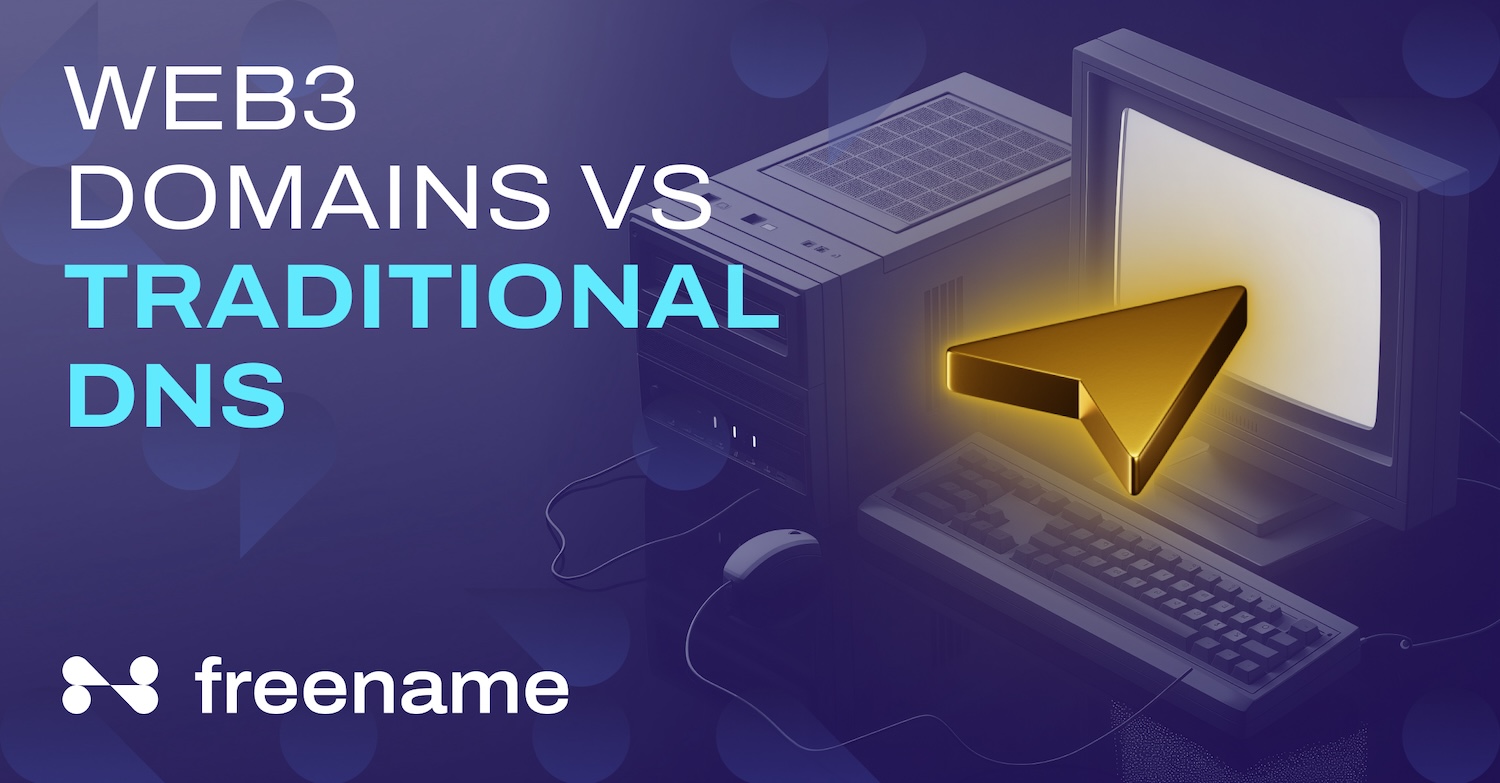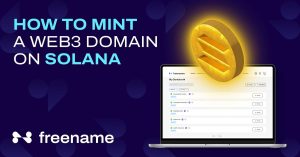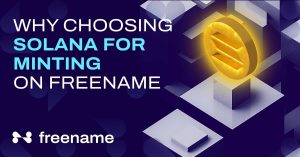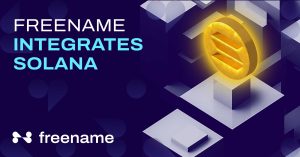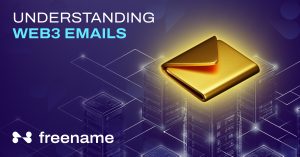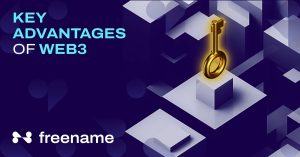With the advent of cryptocurrencies and blockchain technology, tech enthusiasts and crypto experts discovered a new functionality that, although previously unheard of, could revolutionize the very concept of privacy and data ownership—Web3 and Web3 domains.
Today’s internet relies on a foundational system called the Domain Name System (DNS). This system acts like a massive phonebook, converting regular website names into complex IP addresses that computers can understand. However, with Web3, a new era of the internet is on the rise with a new approach to domain ownership – Web3 domains.
This shift has massive implications for how we interact with the online world. Understanding the critical differences between Web3 domains and traditional DNS is extremely important for anyone navigating the future of domain ownership and the decentralized web.
This article explores the building blocks of the decentralized web in contrast to the traditional DNS. In essence, the present versus the future of domain ownership.
Web3 Domains vs Traditional DNS Domains: Quick Comparison
This comparison table provides a concise summary of the critical differences outlined in the article between Web3 domains and the traditional Domain Name System (DNS). This table serves as an introduction to the deeper exploration in the article, highlighting how these two domain systems shape our interaction with the digital world.
| Feature | Traditional DNS | Web3 Domains |
|---|---|---|
| Ownership | Typically rented; requires annual renewal fees. | Permanently owned; no renewal fees after initial registration. |
| Control and Authority | Centrally controlled by organizations like ICANN. | Decentralized; control lies with the domain owner. |
| Privacy | WHOIS directory lists owner details, which can be masked but not omitted. | No personal information required; owner details remain pseudonymous. |
| Security | Susceptible to censorship and centralized points of failure. | Enhanced security due to decentralized storage and blockchain technology. |
| Domain Extensions | Standard extensions (.com, .net, .org, etc.). | Innovative extensions (.crypto, .eth, .nft, etc.). |
| Usability | Used mainly for website addressing. | Can replace complex wallet addresses, enhancing cryptocurrency usability. |
| Technology | Relies on a network of DNS servers to resolve domain names. | Operates on blockchain technology, enabling on-chain resolution. |
| Domain Sale and Transfer | Requires a registrar and often incurs transfer fees. | Direct and transparent sale/transfer via blockchain, often without fees. |
| Development Stage | Mature and widely supported across all platforms. | Still developing, with limited browser support and evolving standards. |
| Applications | Primarily for navigating to websites. | Broader applications including identity management and decentralized web. |
What is a Domain Name System (DNS)
The Domain Name System acts by translating a given domain name into an IP address character set with the help of a Domain Name System Server.
Although there are millions of servers all over the globe, they all act as a singular database. That is why when you input a domain name into your search browser, the browser communicates with the name server so as to find the IP address matching that name.
How Does a Traditional DNS Work?
The traditional Domain Name System works by converting a domain name into a set of characters called an Internet Protocol (IP) address with the aid of a DNS server. However, since all internet-enabled devices are assigned an IP address, for a webpage to load successfully, it must pass through four (4) DNS servers:
DNS Recursor
The DNS Recursor is similar to a librarian who is tasked with finding a particular book in a library. The DNS recursor is a server designed to receive queries from a client’s machine through applications known as web browsers. This recursor is responsible for making extra requests to fulfill the client’s DNS query.
Root Nameserver
The root server is tasked with resolving human-readable host names into IP addresses. Think of it as a book index that points to different words/phrases in a book.
TLD Nameserver
The top-level domain (TLD) can be likened to a specific shelf in a library. The TLD nameserver hosts the extension or ending of a hostname and is the third step in the search for a specific IP address.
Authoritative Nameserver
This can be said to be the final boss in the search for a specific IP address. The authoritative nameserver is like a dictionary that holds the information about DNS records.
What are Web3 Domains?
Web 3 domains are similar to traditional DNS, such that they operate using web extensions. However, unlike traditional DNS, they are launched on smart contracts hosted on public blockchains.
Web3 domains as a service give the user a decentralized crypto domain, using blockchain technology to facilitate domain name registration and resolution entirely on-chain. They are often referred to as Non-Fungible Token (NFT) Domains.
The impact of the Web3 domain service is massive, as users can now register unique domain names that can replace their wallet addresses and decentralized websites (DWebs).
What are Web3 Domain Extensions?
Similar to TLDs of traditional DNS, Web3 domain name extensions refer to the suffix in a URL. Web3 domains offer greater freedom in selecting your preferred extension (e.g., .eth, .bnb).
Web3 domain extensions are becoming increasingly popular, and it is quite easy to distinguish them from traditional top-level domains (TLDs). Some examples are:
- .eth
- .polygon
- .wallet
- .btc
- .bitcoin
- .web3
- .crypto
- .nft
- .zil
- .blockchain
- .coin
- .888
Applications and Benefits of Web3 Domains over Traditional DNS
While traditional domains focus primarily on websites, Web3 domains are proving to be more than that. These blockchain-based domains offer a range of possibilities that are tightly linked to the world of cryptocurrency – especially ownership and decentralization.
Some of the main advantages of Web3 domains over Traditional DNS include:
- Verifiable ownership
- Pseudonymous identity
- Decentralized and secure storage
- Simplified wallet addresses
- Self-sovereign identity
Verifiable Ownership and Free Sale
We are probably used to buying website domains from companies such as Google Domains or GoDaddy. ICANN accredits these registers and holds significant control over your website domain. When you purchase a traditional domain, you’re more or less making a rental purchase since even though you possess the right to use the name for a period (usually a year), you still need to pay the renewal fees or risk losing the domain.
However, that is not the case with Web3 domains. Once minted (registered) on a blockchain, the domain becomes yours and is permanently linked to your crypto wallet. No one can take it away unless you decide to sell it. And since all transactions on the blockchain are visible to the public, the owner’s identity is verifiable at all times.
With Freename you not onlycan registered your Web3 domain but you can even become a Web3 registrar by creating or buying a top-level domain and earning a passive income for registrations within that domain.
Pseudonymous Identity
When you buy a traditional domain name, registrars collect your information and store it in a central registry controlled by ICANN, called the WHOIS directory. While some registrars might mask your details with their own, their privacy policies can change. Ultimately, registrars hold your data; depending on their location, governments can legally compel them to disclose it.
Web3 domain registration offers a stark contrast. You’re identified solely by your crypto wallet address, where your Web3 domain is stored. This emphasis on privacy and security is in line with blockchain principles of protecting private user data with unique identifiers that keep their real-world identities pseudonymous. The blockchain shows public wallet codes, not your personal details, safeguarding your privacy.
Decentralized and Secure Storage
Traditionally, websites rely on a two-step process. First, you buy a domain name. Then, you pay a hosting provider to store your website’s content on their servers. This centralized system is vulnerable to censorship. The Internet Corporation for Assigned Names and Numbers (ICANN) can blacklist your domain, and your hosting provider could shut down your website.
Again, Web3 eliminates this risk. Web3 domains offer a powerful alternative with decentralized storage solutions like InterPlanetary File System (IPFS). IPFS acts as a peer-to-peer network where files are distributed and stored across various devices worldwide. This eliminates a central point of control.
However, IPFS and Web3 technology are still under development as browser support is limited. Only a few browsers, like Brave and Opera, currently offer native integration.
Simplified Wallet Addresses
This functionality is crucial if you own cryptocurrencies and want to use them for payments or DeFi (Decentralized Finance). Web3 interactions require a crypto wallet to store your crypto and NFTs.
However, this makes transactions prone to errors because wallet addresses, which are necessary for receiving and transferring tokens, are made up of long and complicated alphanumeric strings (like “1A1zP1eP5QGefi2DMPTfTL5SLmv7DivfNa”). Hence, the reason wallet addresses must be copied and pasted carefully each time.
All of these can be avoided with the advantageous features of a Web3 domain because long and complicated wallet addresses are easily replaced by readable names such as “charlie.crypto” or “ellie.eth”.
Self-Sovereign Identity (SSI)
Self-sovereign identity (SSI) gives you the power to control your online information and actions. Web3 domains follow this principle, which is one of the key reasons for their popularity and development.
Web3 domain providers, along with other blockchain identity projects, are exploring ways to unify your identity across different platforms. This could involve single sign-on (SSO) solutions, allowing you to use your Web3 domain as a universal login for Web2 and Web3 apps—all with the same digital identity.
Imagine your Web3 domain being more than just an address. Instead, it could become your online username for different services on different platforms—lending protocols, DEXes, metaverse, play-to-earn video games, or social networks.
Web3 Domains vs Traditional DNS Domains: Make Your Choice
Web3 domains represent a unique approach to domain ownership, built on principles of decentralization, security, and user empowerment. While traditional DNS remains relevant to the current web, Web3 domains offer a glimpse into the future, with the potential to transform how we interact and navigate the online world.
Choosing between a traditional domain and a Web3 domain depends entirely on your needs and priorities. Traditional domains offer familiarity and widespread compatibility. However, they lack the security and control features of Web3 domains. Web3 domains, however, have the potential to become a more prominent player in the domain ownership landscape.

